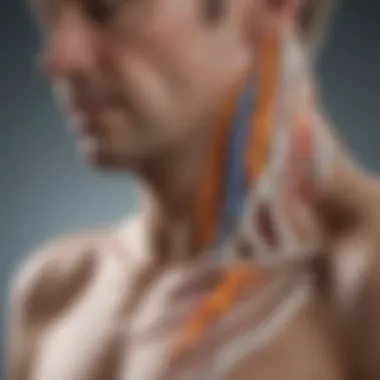Defining Ankylosing Spondylitis: An In-Depth Exploration


Intro
Ankylosing spondylitis (AS) represents a substantial and complex condition, affecting not only the musculoskeletal system but also the overall quality of life for individuals who suffer from it. Understanding AS is essential for both medical professionals and patients alike. This article aims to unfold various aspects of this disease, including its definition, symptoms, causes, diagnostic methods, treatment options, and ongoing research. By presenting a comprehensive overview, it seeks to deepen the understanding of AS and address its impact on daily living.
Research Overview
Methodological Approaches
Research into ankylosing spondylitis utilizes a range of methodological approaches. These often include both qualitative and quantitative studies. Quantitative studies gather statistical data on the prevalence of AS and investigate the effectiveness of treatment options through randomized controlled trials. Meanwhile, qualitative research provides insights into patients' experiences, offering a deeper understanding of how AS affects emotional and physical well-being.
The integration of patient perspectives into research methodologies contributes significantly to the development of more effective treatment strategies and enhances communication between patients and healthcare providers.
Significance and Implications
Understanding ankylosing spondylitis is critical. The disease does not merely cause physical pain and limitations; it can also lead to psychological distress. This highlights the significance of early diagnosis and intervention. Research into new therapeutic options continues to evolve, showcasing the shifting landscape of treatment available to patients. The findings from various studies imply that greater awareness and education about AS can contribute to improved management of the condition and promote better quality of life for affected individuals.
"Funding increasing research into AS will likely lead to innovations in care and treatment, potentially improving outcomes for many patients."
Current Trends in Science
Innovative Techniques and Tools
Innovative techniques are emerging in the field of ankylosing spondylitis research and treatment. For instance, advancements in imaging technology allow for better visualization of the spine and joints, which aids in early diagnosis. MRI and CT scans have improved precision in identifying structural changes in patients. In addition, genetic mapping is being researched to uncover potential predispositions to AS, which may pave the way for personalized medicine.
Interdisciplinary Connections
Ankylosing spondylitis often requires an interdisciplinary approach for comprehensive management. Specialists in rheumatology, physical therapy, and psychology collaborate to ensure that all aspects of a patient's health are addressed. This connection highlights the importance of well-coordinated care that prioritizes communication among healthcare providers.
Such an interdisciplinary model enhances the treatment experience for patients, allowing for tailored care plans that suit individual needs.
Prologue to Ankylosing Spondylitis
Ankylosing spondylitis is more than just a medical term; it represents a significant aspect of rheumatology and affects a substantial segment of the population. Understanding this condition is essential due to its implications on overall health and wellness. By comprehensively exploring ankylosing spondylitis, we derive insights into its pathophysiology, symptoms, diagnosis, and treatment approaches.
A thorough examination of ankylosing spondylitis informs both healthcare professionals and patients. For professionals, detailed knowledge aids in accurate diagnosis and effective management strategies. For patients, awareness about their condition bolsters empowerment and promotes active participation in care decisions.
This section emphasizes the importance of recognizing the nuances of ankylosing spondylitis, not just as a diagnosis but as a chronic condition that shapes daily life. Recognizing the symptoms early can facilitate timely intervention, which is crucial in delaying disease progression and maintaining quality of life.
Understanding the Condition
Ankylosing spondylitis primarily targets the spine and the sacroiliac joints, leading to inflammation and, in severe cases, ossification of spinal tissues. This explains the etymology of the name: 'ankylosing' refers to the fusion of bones, while 'spondylitis' pertains to inflammation of vertebrae. Individuals with AS often experience chronic pain and stiffness, significantly impairing mobility.
Research indicates a genetic correlation between ankylosing spondylitis and the HLA-B27 antigen, with a higher prevalence noted in individuals carrying this marker. However, not all individuals with this antigen will develop AS, suggesting that environmental factors may also play a role in triggering the condition.
Recognizing the symptomatology of ankylosing spondylitis requires a multifaceted approach:
- Common Symptoms: Chronic back pain, stiffness, particularly in the morning or during periods of inactivity.
- Symptom Progression: Symptoms may fluctuate, potentially becoming more severe over time.
- Impact on Functionality: Daily activities become increasingly challenging due to debilitating pain and reduced flexibility.
These aspects highlight the chronic nature of ankylosing spondylitis and its far-reaching consequences in a person's life. Addressing the complexities surrounding the diagnosis and treatment options can significantly enhance outcomes.
"Ankylosing spondylitis is not merely an experience of physical pain, but also an emotional and psychological journey for those affected."
In summary, understanding ankylosing spondylitis sets the stage for the subsequent exploration of its definition, pathophysiology, and broader implications on health management.
Defining Ankylosing Spondylitis
The significance of defining ankylosing spondylitis (AS) lies in its potential to enhance understanding of this complex condition. Clear definitions bring clarity to its symptoms, progression, and impact on individuals’ lives. A precise understanding of AS also fosters improved communication between patients and healthcare providers. This section aims to explore the medical definition of AS and its underlying pathophysiology. In turn, this investigation provides essential insights that may inform treatment strategies and improve patients' outcomes.
Medical Definition


Ankylosing spondylitis is classified predominantly as a chronic inflammatory disease. It is primarily characterized by inflammation of the spine and the sacroiliac joints, which are located in the lower back. The medical community recognizes AS as a subset of spondyloarthritis. The condition often manifests with pain and stiffness, most notably during periods of rest. Such symptoms may gradually improve with exercise.
The disease tends to affect young adults, usually beginning in late adolescence to early adulthood. The diagnosis of AS is often confirmed through clinical evaluation and imaging techniques. The severity of AS can vary widely among individuals, making each case unique. Thus, understanding this fact is crucial for developing tailored treatment approaches.
Pathophysiology of AS
The pathophysiology of ankylosing spondylitis is complex and involves multiple factors. Central to this process is the immune system's abnormal response. In AS patients, inflammation occurs due to a dysregulated immune response, leading to chronic joint inflammation. Major histocompatibility complex (MHC) class I, particularly HLA-B27, plays a pivotal role in this autoimmune activity. A significant percentage of AS patients express this genetic marker, which indicates a heightened risk for developing the condition.
As inflammation persists, it may ultimately result in the formation of new bone, leading to a condition termed "ankylosis." This can cause fusion of the vertebrae and rigidity of the spine, severely limiting mobility. The involvement of other joints and extra-articular symptoms, such as uveitis or psoriasis, further complicates the clinical picture.
In summary, defining ankylosing spondylitis enables a more profound understanding of its implications for patients. It provides the groundwork for exploring symptoms, causes, and treatment options later in this article.
"A better understanding of the medical definitions and pathophysiology of ankylosing spondylitis can lead to more effective management strategies for those affected by the condition."
Through exploration of its definition, this article aims to promote awareness, research, and dialogue surrounding AS.
Symptoms of Ankylosing Spondylitis
Understanding the symptoms of ankylosing spondylitis (AS) is crucial for both early diagnosis and effective management of the condition. Recognizing these indicators can lead to timely intervention, which may slow disease progression and improve quality of life. Given the complexities of AS, symptoms can often be multifaceted, appearing at different stages and affecting individuals in unique ways. This section breaks down the symptoms into three categories: early symptoms, progressive symptoms, and extra-articular symptoms.
Early Symptoms
Early symptoms of ankylosing spondylitis typically emerge gradually. Many patients first experience chronic back pain. This pain often has a specific character: it is usually worse in the morning and may improve with activity. Other common early symptoms include stiffness, particularly in the lower back and hips. As inflammation develops, some individuals may feel discomfort in these areas during nighttime hours, disrupting their rest.
Moreover, the sickle-like sensation can extend to the chest and shoulders, making some movements difficult. Early identification of these symptoms is fundamental because they may serve as precursors to more serious complications. The likelihood of developing further musculoskeletal issues increases without prompt recognition. Individuals noting these initial signs should seek medical counsel promptly to ensure accurate evaluation.
Progressive Symptoms
As ankylosing spondylitis advances, symptoms often evolve or intensify. Progressive stiffness and pain may lead to significant limitations in mobility and overall quality of life. Many patients report increased difficulty in performing daily tasks, which progressively affects their social and professional engagements. Additionally, the inflammation can cause fusion of the vertebrae, leading to a permanently hunched posture. This condition is described as "bamboo spine" in severe cases, reflecting the rigid appearance of the back.
Fatigue is another symptom that commonly manifests at this stage. Patients may feel unusually tired, even without engaging in strenuous activities. Importantly, the progression of symptoms may influence psychological well-being as well, making mental health considerations vital in management strategies.
Extra-Articular Symptoms
Ankylosing spondylitis is not solely an issue of the spine and joints; it can also trigger extra-articular symptoms. These may include inflammation in other areas of the body, which can often be overlooked during diagnosis. Commonly reported extra-articular symptoms involve inflammation of the eyes, a condition known as uveitis or iritis. This can cause pain, redness, and sensitivity to light, requiring prompt ophthalmologic evaluation.
Furthermore, cardiovascular involvement can occur, leading to issues such as aortic regurgitation or conduction disturbances. Skin conditions like psoriasis have also been associated with AS, alongside gastrointestinal issues, including inflammatory bowel disease. Recognizing these additional symptoms is essential as they can complicate treatment plans and patient management.
Ankylosing spondylitis reflects a broad spectrum of symptoms encompassing various systems in the body. Acknowledging these complexities helps in developing a comprehensive care plan.
Causes and Risk Factors
Understanding the causes and risk factors of ankylosing spondylitis is crucial for comprehending the condition. This section explores these elements to shed light on how they may contribute to the onset of the disease. Identifying risk factors allows healthcare professionals to better assess individual cases and develop proactive strategies for management and treatment.
Genetic Factors
Genetic predisposition plays a significant role in ankylosing spondylitis. Approximately 90% of individuals with AS carry the HLA-B27 antigen. This genetic marker is commonly found in populations with a higher prevalence of the disease.
However, possessing the HLA-B27 antigen does not guarantee the development of ankylosing spondylitis. Many people with this antigen never exhibit symptoms. Thus, while genetic factors influence risk, they are part of a broader picture.
First-degree relatives of AS patients have a greater chance of developing the condition. Research indicates that the heritability of AS is around 90%, underscoring the importance of investigating family health histories when diagnosing and treating this disease.
Environmental Triggers
Environmental factors can also contribute to the development of ankylosing spondylitis. Infections are often highlighted as potential triggers. Certain bacterial infections may initiate the inflammatory process in susceptible individuals, leading to AS.
Additionally, lifestyle choices may play a role in the disease's onset or exacerbation. Factors such as:
- Smoking: Studies indicate a correlation between smoking and increased severity of symptoms.
- Diet: An unhealthy diet may influence inflammatory processes and overall health.
- Physical inactivity: Lack of regular exercise can lead to stiffness and worsen symptoms.


Overall, while not the sole reason, environmental elements might interact with genetic predispositions, thus influencing the likelihood of developing ankylosing spondylitis.
Understanding the multifactorial causes of ankylosing spondylitis clarifies its complexity and emphasizes the importance of a well-rounded approach to prevention and treatment.
Diagnosis of Ankylosing Spondylitis
Accurate diagnosis of ankylosing spondylitis is crucial. Early identification can significantly affect treatment outcomes. The complexity of AS often leads to misdiagnosis or delay in appropriate intervention. Clinicians must utilize a combination of methods to arrive at a definitive diagnosis.
Clinical Assessment
During clinical assessment, healthcare providers gather comprehensive medical histories. A patient’s described symptoms, including back pain and stiffness, play an essential role. A physical examination helps assess mobility and any signs of inflammation. Doctors may also ask about family history, as AS often has hereditary components.
Symptoms commonly present during an assessment include:
- Chronic back pain that improves with exercise and worsens with rest.
- Morning stiffness lasting more than 30 minutes.
- Inflammation of the eyes, known as uveitis.
Early clinical assessment can help in determining the likelihood of AS. General practitioners may also refer patients to rheumatologists for specialized assessment.
Imaging Techniques
Imaging techniques are instrumental in confirming a diagnosis of ankylosing spondylitis. The two most common methods used are X-rays and magnetic resonance imaging (MRI).
- X-Rays: These can reveal changes in the sacroiliac joints, critical for diagnosing AS. Radiologists look for signs of bone fusion, an important indicator of the disease’s progression.
- MRI: This method is more sensitive than X-rays. It can detect early inflammatory changes in the sacroiliac joints and spine. MRI plays a significant role in identifying AS before structural damage occurs, facilitating earlier treatment.
Timely imaging can provide strong evidence supporting an AS diagnosis, influencing the subsequent direction for treatment.
Laboratory Tests
Laboratory tests are complemented by clinical assessment and imaging. Various tests help rule out other conditions and support an AS diagnosis.
One important laboratory test is the HLA-B27 antigen test. About 90% of people with AS may test positive for this antigen. However, it is important to note that not everyone with this antigen develops AS, and some with the condition may test negative. Therefore, the HLA-B27 test is not conclusive on its own.
Other possible blood tests include:
- Inflammatory markers: These may indicate the presence of systemic inflammation, commonly found in autoimmune conditions.
- Complete blood count: This checks for anemia, which may accompany chronic disease.
Each of these elements plays a crucial part in painting a complete picture for diagnosing ankylosing spondylitis.
Accurate diagnosis allows for more effective management and improved patient quality of life.
Treatment Options for Ankylosing Spondylitis
Understanding and managing Ankylosing Spondylitis (AS) requires careful consideration of treatment options. The goal of any treatment plan is not only to alleviate symptoms but also to improve functional outcomes and enhance overall quality of life. With an array of approaches available, patients and healthcare providers must explore individual needs, preferences, and capabilities.
Medication Approaches
Medications play a critical role in managing symptoms of Ankylosing Spondylitis. Non-steroidal anti-inflammatory drugs (NSAIDs) are often the first line of defense. These drugs help reduce pain and inflammation, allowing patients to maintain mobility. Common NSAIDs include Ibuprofen and Naproxen.
In some cases, disease-modifying anti-rheumatic drugs (DMARDs) may be appropriate. These medications slow disease progression and can prevent permanent damage to joints. Biologic therapies, like Tumor Necrosis Factor (TNF) inhibitors, have emerged as effective treatments for AS, particularly in cases that do not respond well to traditional therapies.
The choice of medication varies widely among individuals and must consider factors such as side effects, kidney function, and potential interactions. Regular monitoring is necessary to adjust treatments as symptoms evolve.
Physical Therapy
Incorporating physical therapy into treatment for Ankylosing Spondylitis is essential for maintaining joint flexibility and overall mobility. Physical therapists tailor exercise programs to suit the specific needs of individuals with AS. This may involve strengthening exercises to improve posture and stability as well as stretching routines to enhance flexibility.
The significance of physical therapy cannot be overstated. It empowers patients by improving their physical condition and equipping them with self-management techniques. Furthermore, it helps to alleviate pain, reduce stiffness, and ultimately combat the progression of the disease. Gentle activities like swimming or cycling may also provide benefits without excessive strain on the joints.
Lifestyle Modifications


Lifestyle changes can significantly influence the management of Ankylosing Spondylitis. It is crucial to maintain a healthy weight, as extra body weight can exacerbate symptoms. A balanced diet rich in anti-inflammatory foods, such as fruits, vegetables, and omega-3 fatty acids, is recommended.
In addition, regular exercise is vital. Beyond physical therapy, engaging in consistent aerobic activities enhances cardiovascular health and aids in maintaining joint function. Practices like yoga or tai chi may help improve flexibility and contribute to relaxation.
Sleep hygiene is another important consideration. A good night’s rest can improve pain perception and enhance overall well-being. Adopting a sleep routine and ensuring proper sleep posture can make a considerable difference.
“A multi-faceted approach, including medication, physical therapy, and lifestyle changes, is essential for managing Ankylosing Spondylitis effectively.”
In summary, the treatment options for Ankylosing Spondylitis encompass a variety of strategies. Each patient’s experience with AS can differ, necessitating personalized treatment plans. Exploring and utilizing medications, physical therapy, and lifestyle modifications create an environment for improved outcomes and enhanced quality of life.
The Impact of Ankylosing Spondylitis on Daily Life
Understanding how ankylosing spondylitis affects daily life is essential for both patients and caregivers. The condition can significantly alter how individuals perform everyday activities, shaping not only physical capabilities but also emotional well-being. This section will explore the distinct impacts of AS, focusing on mobility and social ramifications. By illuminating these aspects, we hope to enhance the comprehension of challenges faced by those who live with this chronic condition.
Impact on Mobility and Function
Ankylosing spondylitis often leads to a gradual decline in mobility due to inflammation and stiffness in the spine and joints. Individuals may find it increasingly difficult to engage in basic activities such as bending, lifting, or even standing for prolonged periods. The primary consequences include:
- Reduced Range of Motion: AS causes inflammation in the spine, which can lead to fusion of vertebrae over time. This reduction in flexibility may restrict twisting or bending.
- Postural Changes: As AS progresses, many individuals develop a stooped posture due to pain or mechanical restrictions, further impacting movement.
- Functional Limitations: Everyday tasks, from tying shoes to climbing stairs, might become laborious, resulting in a need to adjust routines or rely on assistive devices.
Each of these issues can accumulate, leading to a cycle of physical limitation. Caregivers often need to assist with tasks once taken for granted, altering the dynamics of daily life. Thus, understanding mobility is paramount when considering the comprehensive impact of ankylosing spondylitis on an individual’s functional abilities.
Social and Psychological Effects
The effects of ankylosing spondylitis extend beyond the physical realm, penetrating into emotional and social dimensions as well. Chronic pain and fatigue can lead to feelings of isolation and frustration.
- Social Isolation: Many individuals with AS find themselves withdrawing from social activities due to discomfort or embarrassment about their condition. The inability to participate fully in social gatherings can lead to feelings of loneliness.
- Mental Health Challenges: The burden of chronic illness often increases the risk of anxiety and depression. Coping with the persistent nature of symptoms can wear down mental resilience.
- Impact on Relationships: Relating to friends and family may be challenging. Partners or family members may inadvertently feel burdened, creating strain in relationships. Open communication becomes vital for maintaining connections.
"The hidden struggles of chronic illness often go unnoticed, leading those with ankylosing spondylitis to feel isolated even among loved ones."
Addressing these social and psychological aspects is crucial for holistic care. Awareness of these impacts not only encourages compassionate engagement from family and friends but also highlights the need for professional support services, such as counseling or support groups.
Future Directions in Research
Future directions in ankylosing spondylitis (AS) research play a critical role in understanding and managing this complex condition. Keeping up with the latest advancements can lead to better therapeutic approaches, improved patient outcomes, and a deeper understanding of the disease itself. Research efforts focus on various innovative strategies, which include emerging therapies, the development of new diagnostic criteria, and the examination of the long-term effects of AS on affected individuals.
Emerging Therapies and Investigations
In recent years, researchers have explored numerous potential therapies for ankylosing spondylitis. One promising area is the use of biologic medications. Options like adalimumab and etanercept have shown efficacy in reducing inflammation and pain. The advent of Janus kinase (JAK) inhibitors, such as tofacitinib, represents another potential avenue. These therapies target specific pathways in the immune system, promoting a more tailored approach to treatment. Researchers are also investigating novel gene therapies and stem cell treatments as potential future options.
In addition to medication, multidisciplinary approaches involving physical therapy, occupational therapy, and psychological support are gaining traction. The integration of these complementary practices can help manage symptoms more effectively. Through clinical trials and investigative studies, researchers aim to identify the long-term safety and effectiveness of these therapies.
"Continued research is essential to unlock new treatment paradigms for better management of ankylosing spondylitis."
Longitudinal Studies
Longitudinal studies are vital in understanding the progression and impact of ankylosing spondylitis over time. These studies follow individuals with diagnosed AS for extended periods, collecting data on symptoms, treatment responses, and quality of life. Such studies reveal how the disease evolves, which can guide healthcare providers in delivering more personalized care.
Understanding the lifetime journey of AS patients also aids in recognizing patterns of flare-ups, remission, and the development of complications. This information is critical for establishing preventive strategies to mitigate long-term disability and promote better life quality.
Furthermore, longitudinal studies can explore the interplay of genetic and environmental factors in AS. This multifactorial approach can clarify potential triggers and help demystify the underlying mechanisms of the disease. In turn, this may lead to innovative preventive measures and therapies tailored to individual patient profiles.
In summary, future research into ankylosing spondylitis is essential. Emerging therapies combined with comprehensive longitudinal studies provide a backbone for understanding and managing this condition effectively. As research progresses, the hope is for continuous improvement in treatments and overall patient care.
The End
In concluding this exploration of ankylosing spondylitis (AS), it is crucial to emphasize the multi-faceted nature of this condition. Not only does AS have significant implications on individual health, but it also influences daily activities, relationships, and overall quality of life. The discussion around AS has illustrated the complexity of diagnosis and treatment, highlighting the importance of a tailored approach for each patient.
Understanding ankylosing spondylitis is not simply an academic exercise. It directly impacts the management of symptoms and the efficacy of interventions. For professionals in the healthcare sector as well as individuals affected by the condition, a nuanced understanding of AS is integral. Ongoing research is vital for uncovering new treatment methods and improving patient outcomes. This creates a hopeful outlook for managing the condition more effectively.
"Effective management of ankylosing spondylitis requires vigilance, education, and a collaborative approach between patient and healthcare provider."
Summary of Key Points
- Definition and Understanding: Ankylosing spondylitis is primarily characterized by inflammation of the spine and sacroiliac joints.
- Symptoms: Symptoms can vary between early signs and progressive issues, including both spinal and extra-articular manifestations.
- Causes: A combination of genetic and environmental factors contribute to the risk of developing AS, with certain genes playing a critical role.
- Diagnosis: Clinicians rely on clinical assessment, imaging techniques, and laboratory tests to achieve an accurate diagnosis of AS.
- Treatment Options: Various medication approaches, physical therapies, and lifestyle modifications help to manage the symptoms.
- Impact on Life: AS affects mobility and can lead to psychological impacts, thus requiring a comprehensive support network for those affected.
- Research Directions: Future studies aim to identify new therapies and gather more longitudinal data on the condition.
In summary, a thorough understanding of ankylosing spondylitis equips patients, researchers, and healthcare professionals with essential insights for managing this complex disease.



